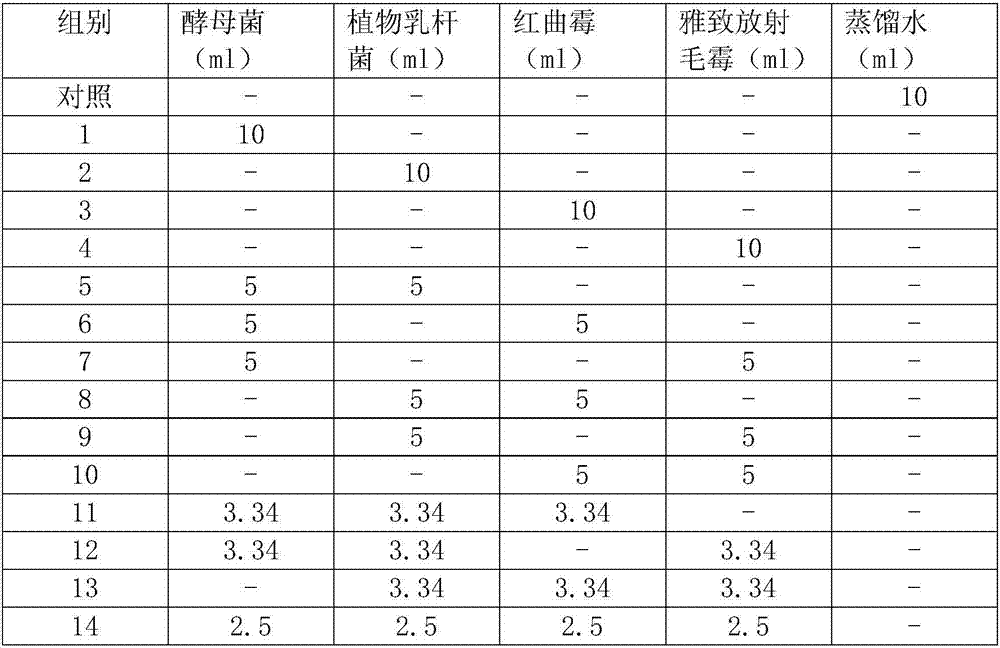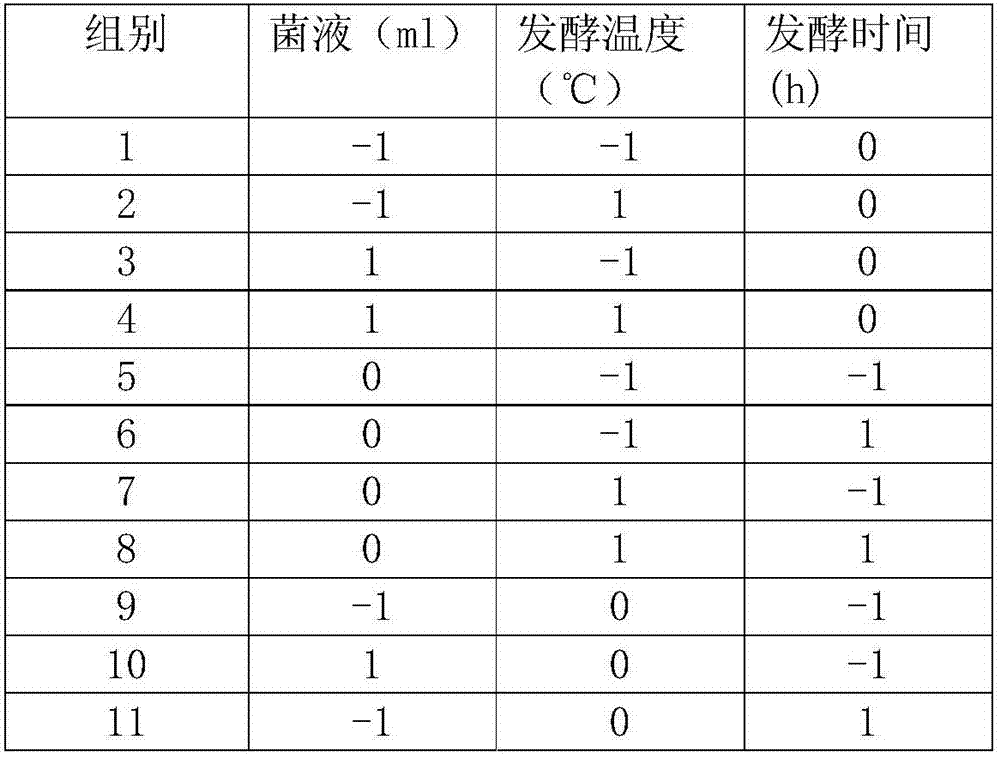Method for reducing content of cyanides in cassava residues
A cassava residue and cyanide technology, which is applied in the directions of microorganism-based methods, methods using microorganisms, biochemical equipment and methods, etc., can solve problems such as limiting the use of cassava residues in large quantities.
- Summary
- Abstract
- Description
- Claims
- Application Information
AI Technical Summary
Problems solved by technology
Method used
Image
Examples
Embodiment 1
[0031] Test one:
[0032] 1.2. Experimental design
[0033] 1.2.1 Preparation of cassava residue fermented material
[0034] In this experiment, cassava residue was used as the fermentation raw material. Sampling was taken to determine the hydrocyanic acid content before treatment.
[0035] 1.2.2 Optimal combination screening of mixed strains
[0036] The activated yeast, Lactobacillus plantarum (Lactobacillus plantarum (Lactobacillus plantarum) SN12#, preservation number is CCTCC NO: M 2015699), Monascus (Monascus ruber (Monascus rubber) strains, purchased from China's common microbial strains Collection Center, the preservation number is CMCC NO.3.4639), the culture solution of Actinomucorelegans (Actinomucorelegans, purchased from the China Common Microorganism Culture Collection Center, the preservation number is CMCC NO.3.2468), according to different strain combinations , a total of 15 combinations, 4 repetitions for each combination, each repetition is divided into ...
Embodiment 2
[0075] A method for reducing the cyanide content of cassava dregs, mixing yeast and Mucor actinosa at a volume ratio of 5:3 to obtain a mixed bacterial solution, then mixing 10mL of the mixed bacterial solution with 180g of cassava dregs, and then proceeding at 25°C Ferment for 48h.
[0076] Yeasts include Candida alcoholophilus and Candida rugosa with a volume ratio of 3:2; Candida alcoholophilus is Candida ethanolica Y1 (Candida ethamoLica) isolated from buffalo milk , the preservation number is CCTCC NO: M 2016467; Candida rugosa is Candida rugosa Y7 (Candidarugosa) isolated from buffalo milk, and the preservation number is CCTCC NO: M 2016468; said Actinomucorelegans ), purchased from China Common Microorganism Culture Collection Center, the preservation number is CMCC NO.3.2468.
[0077] Before use, the yeast and Actinomucor elegans were pre-acclimated.
[0078] Wherein, the method for the domestication and cultivation of Mucor radiata Yazhi, the specific steps are as f...
Embodiment 3
[0097] A method for reducing the cyanide content of cassava dregs, mixing yeast and Mucor actinosa at a volume ratio of 5:1 to obtain a mixed bacterial liquid, then mixing 20mL of the mixed bacterial liquid with 250g cassava dregs, and proceeding at 31°C Ferment for 96h.
[0098] Yeasts include Candida alcoholophilus and Candida rugosa with a volume ratio of 3:1; Candida alcoholophilus is Candida ethamoLica isolated from buffalo milk , the preservation number is CCTCC NO: M 2016467; Candida rugosa is Candida rugosa Y7 (Candidarugosa) isolated from buffalo milk, and the preservation number is CCTCC NO: M 2016468; said Actinomucorelegans ), purchased from China Common Microorganism Culture Collection Center, the preservation number is CMCC NO.3.2468.
[0099] Before use, the yeast and Actinomucor elegans were pre-acclimated.
[0100] Wherein, the method for the domestication and cultivation of Mucor radiata Yazhi, the specific steps are as follows:
[0101] (1) Strain activat...
PUM
 Login to View More
Login to View More Abstract
Description
Claims
Application Information
 Login to View More
Login to View More - R&D
- Intellectual Property
- Life Sciences
- Materials
- Tech Scout
- Unparalleled Data Quality
- Higher Quality Content
- 60% Fewer Hallucinations
Browse by: Latest US Patents, China's latest patents, Technical Efficacy Thesaurus, Application Domain, Technology Topic, Popular Technical Reports.
© 2025 PatSnap. All rights reserved.Legal|Privacy policy|Modern Slavery Act Transparency Statement|Sitemap|About US| Contact US: help@patsnap.com



